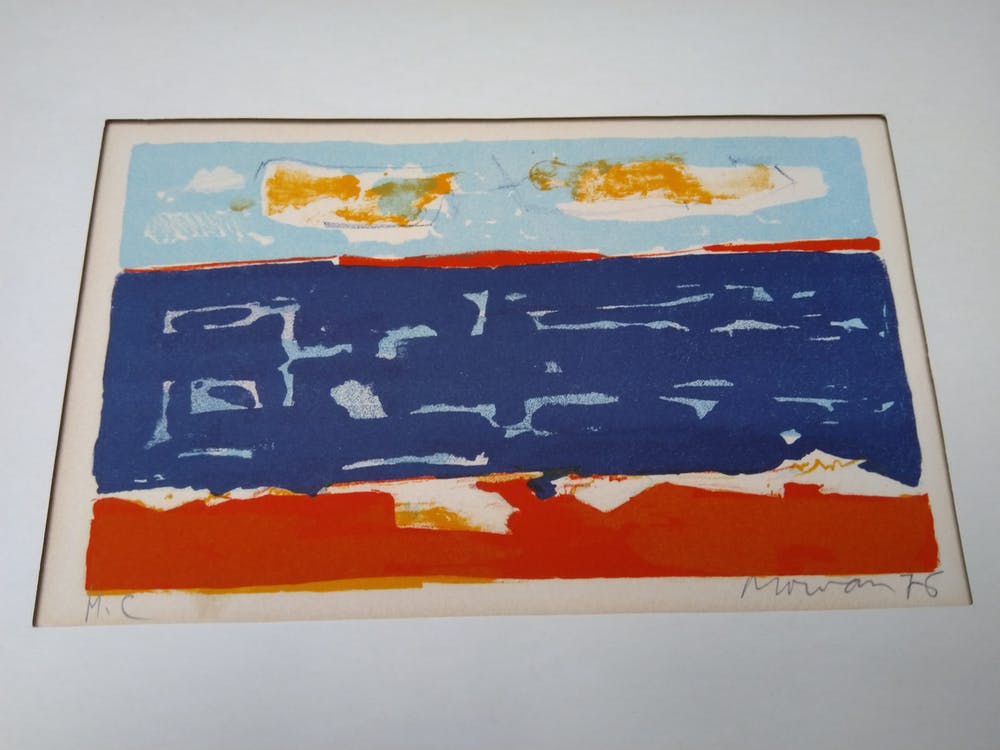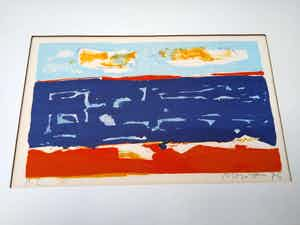

Jean Jacques Morvan (1928)
Artist
Biography 1928, January 7 Jean-Jacques Morvan is born in Paris. His family is from Brittany. 1939 - 1940 After the outbreak of the world war, he and his sister stayed for two years in Saint Jean d'Ángély. He is impressed by the desperate refugees from the Netherlands, Belgium and Northern France. He wrote his first poems there and made his first drawings. 1940, June 17, Capitulation of Paris. 1941 Morvan returns to Paris and will remain there for the rest of the war. A Jewish classmate is deported. Classes will be moved to the air-raid shelters under the Lyceum. 1944, August 24 Liberation of Paris. Morvan is admitted to the Art Academy (École des Beaux Arts), but only lasts one day. 1945 - 1946 Morvan is involved in the reception of survivors from the concentration camps, in Hotel Lutétia. He is admitted to the applied arts school (École des arts décoratifs). To earn a living he works as a stage actor and journalist. For his paintings he sometimes uses toothpaste and the like as paint due to lack of money. 1947 Morvan shows his work for the first time at the annual exhibition for artists under the age of thirty (Salon des moins de 30 ans), assisting in the production of a film. 1948 - 1949 Military service. He also continues to act and he gets a studio in the army where he can draw and paint. 1949 - 1950 Focuses more intensively on painting. Exhibits paintings on paper in the Quartier du Marais, but does not sell anything. To earn money, he works in the Parisian Halls and remains active as a journalist and stage actor. 1951 Publishes his first drawings. His first own exhibition in a gallery in Paris received positive reviews. 1954 - 1956 Travels to Corsica several times; his style changes with his impressions of the Mediterranean world. He will enthusiastically engage in lithography. 1957 - 1963 Buys a house with a studio in Provence and lives there alternately, in Paris and in Brittany. Returns to elemental shapes and themes (waves, fire). He regularly has small exhibitions and receives critical acclaim. The actress Cathérine Sauvage and the writer Albert Camus are among the first collectors of his work. In 1962 he exhibits in New York. 1964 Exhibits at the famous Katia Granoff gallery in Paris. It is his definitive breakthrough. He gets married. 1965 - 1967 Makes trips to the Greek islands, Canada, Morocco, Jordan, China and Russia, among others. The vast landscape of Canada in particular influences his work. After the birth of his daughter, he also paints babies. 1968 - 1969 Trip to Mexico. Then works in Canada for a year with a grant from the French Council of the Arts (Grand Boursier du conseil des Arts) 1969 -1970 Has important exhibitions at the Quebec Museum, at the Museum of Fine Arts of Mexico and at the Maison de la Culture in Rennes. Making a film with Guy de Belleval. Publishes a collection of poems. Paints a lot and explores the possibilities of various materials. 1971 - 1972. Travels and works in Tunisia. Five major museums in Orléans, Nancy, Besançon, Tours and Le Havre present an overview of Morvan's work under the title 'Twenty Years of Painting'. 1973 Travels to Japan and again to Canada. After his return to the south of France, the sea becomes one of his main themes. He makes use of sand and textiles and also produces reliefs and sculptures 1974 - 1977 He is once again captivated by the theme of deportations, which has never left him since 1945. Under the title Nuit et brouillard (Night and mist), the Musée de la Résistance et de la Déportation in Besançon is exhibiting fifty works on this theme. 1977 - 1987 Besides the sea, Morvan discovers other maritime subjects. He receives many commissions and is distinguished as Grand Peintre Officel de la Marine and Peintre Titulaire de la Marine. Many exhibitions follow throughout France. In 1981 the Center Jean Moulin in Bordeaux buys a large part of the works about the Second World War. 1993 Exhibition of 46 works on violence and intolerance in Brive and later Bordeaux. Manufactures a monument in honor of the famous French resistance fighter Jean Moulin in Orgon. 1997 Retrospective of Morvan's work in many major cities in France. 1998 - 2000 Returns to Paris focuses more on writing stories and poems, which he publishes in the collection Côte du Trégor.

Jean Jacques Morvan - onbekend
Prints (signed) - 1 bid
Log in or register to view the yield - 14 x 23 cm (h x w)
Sell a similar item in auction
Sell art of Jean Jacques Morvan
Kunstveiling is the platform where you can successfully sell art of Jean Jacques Morvan online! With a large audience of art lovers you will easily find a buyer for the beautiful artwork of Jean Jacques Morvan that you want to sell. Would you like to read more about selling art via Kunstveiling? Then click on the link and see the instructions to create an online auction yourself!
Why would you sell art of Jean Jacques Morvan via Kunstveiling?
Sell art of Jean Jacques Morvan through the largest auction platform in the Netherlands and Flanders, focused on online buying and selling of art, jewellery and design. If you are a member of Kunstveiling, you can easily sell unique works of art of Jean Jacques Morvan with your personal Kunstveiling account. At Kunstveiling you pay no sellers' commission on successful sales.
Selling art online by Jean Jacques Morvan and other recognised artists is an exciting and dynamic process and can give quick results. With many thousands of active buyers you will find a large and varied audience for artworks by Jean Jacques Morvan that you want to sell through the auction. In addition, Kunstveiling offers the possibility to sell your artworks of Jean Jacques Morvan through the Auctioneer via the de-collecting service. We will gladly take the work involved in the sale of your artworks of Jean Jacques Morvan out of your hands.
How do I offer an artwork of Jean Jacques Morvan for sale through Kunstveiling?
To sell art of Jean Jacques Morvan through Kunstveiling you need an account. You can easily create an account here. Before you start selling art of Jean Jacques Morvan via Kunstveiling read the auction rules carefully. Offering art of Jean Jacques Morvan for sale via the online auction is quick and easy. Through the form you specify the details of the artwork of Jean Jacques Morvan, including the technique used, dimensions and an indication of the condition. You can also add pictures of the work of art by Jean Jacques Morvan. For tips on taking striking photographs, also read our auction tips. Finally, you give an opening bid, and select the end time of the auction.
After the auction has ended, you will automatically receive a message with the details of the winning bidder so that you can continue processing the sale. If the artwork of Jean Jacques Morvan is not sold, consider re-offering the work and possibly lower the opening bid to increase the chances of a successful sale of an artwork of Jean Jacques Morvan!
I want to sell art by Jean Jacques Morvan. What is a realistic opening bid?
Do you have an artwork of Jean Jacques Morvan that you would like to sell, but are you unsure about a suitable opening bid? Then request a free, no-obligation valuation from our Auctioneers. They are happy to give you advice and a realistic estimate of the value of your work of art of Jean Jacques Morvan. You can read more information about submitting an online request for an auction estimate by clicking on the link.
 French
French